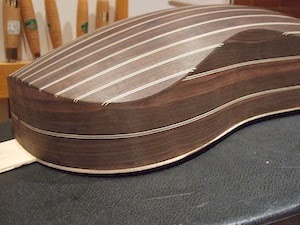I was impatient to hear what my Checchucci sounded like. The harmonic barring of the original is minimal and somewhat unusual. Photos taken during the restoration of the guitar show only three harmonic bars; one between the rose and the neck, a second immediately to the bridge side of the rose and a third about half way between the rose and the bridge. Both of the last two bars are angled off the horizontal by about seven degrees.
 |
| Photo: Checchucci, MFA, Boston |
The Museum of Fine Arts, Boston has an audio recording attached to the guitar's webpage http://www.mfa.org/collections/object/guitar-128556 but it was no longer functioning when I last tried it. This is unfortunate because there are few opportunities to hear original instruments. Hopefully, the malfunction is temporary.
 |
| My Voboam barring pattern |
I couldn't decide whether to use the barring design as it is appears in the restoration photo or to adapt some features of it or to use another system all together. Players have told me that they distinguish between styles of baroque guitars; in general preferring vaulted back guitars for strumming and flat back ones for plucking. I agree, but I think it is possible to expand on this perception. In today's period guitar world vaulted back guitars are usually represented by Italian models that were built in the first half of the 17th century. Flat back guitars are often patterned after French examples from the 1670 - 1690 (I know there are popular exceptions and guitars by Stradivari and Koch are examples). Furthermore, it seems that guitars dating from later in the 17th century were fitted with additional struts such as those from the Voboam family (see my post from March 6, 2012). These features coincide with the era from composer-guitarist Corbette to Visée when a premium was placed on instruments that were ultra-responsive and well-balanced.
 |
| Photo: MFA, Boston |
 |
| My Checchucci barring solution |
Although I know of no historical examples of two angled harmonic bars * (see edit) I am familiar with variations on the idea. Two examples come to mind; the Ashmolean Stradivari built in 1688 has a single bar angled toward the treble but placed further away from the rose and many makers, through several centuries, have used a straight bar or angled bar placed just above the bridge. I have used both previously, on guitars from various eras, but never together.
My solution to barring my Checchucci was to acknowledge his contribution by placing two bars in the same positions that he chose but angling them toward the treble instead of the bass. In order to keep the total barring light I again followed Checchucci's example and omitted the second strut that I usually put across the upper bout and installed a single "finger" directly under the first string instead of the flat wood plate (which may not be original) to support the belly frets.
When I strung my model and played it in my limited way, it was fully resonate across its register with strength and clarity in the treble and a measure of silvery lightness throughout. I thought that it should have a different combination of attributes than my Voboam, Koch and Oth models and it does.
Now I am ready to inlay the "ivory" lozenges that make up the border of the soundboard. But while I'm working on that I'll describe assembling the neck and peghead in my next post.
All of December has been very festive and I'm enjoying the holidays and the opportunity to spend the days with family and friends and activities that I seldom have time for.
So, Happy New Year and wishing you all a healthy, happy and prosperous 2014!
* I was leafing through my copy of the catalogue of Royal College of Music, Museum of Instruments, Part III, European Stringed Instruments, and found an x-ray photo of RCM 22, an unattributed baroque era guitar. The x-ray clearly shows two diagonal harmonic bars tilted toward the treble in much the same location as I chose. Since I examined this guitar in 2006 I must have been aware of the barring pattern but allowed it to drift too deeply into my subconscious.
The catalogue is available from; http://www.cph.rcm.ac.uk/GenPublicationsMuseumCat3.htm
January 25, 2014.










